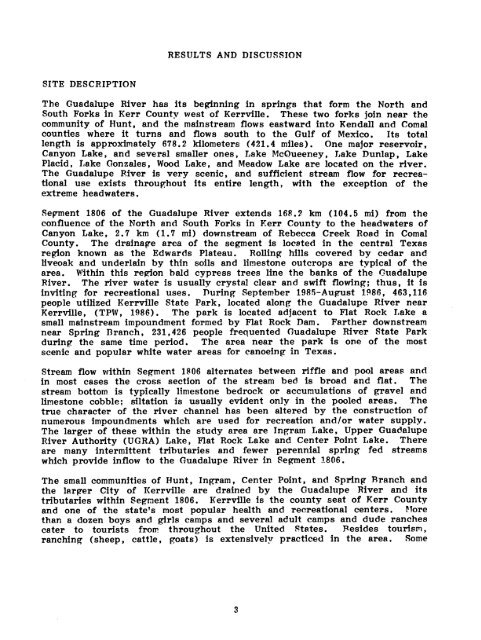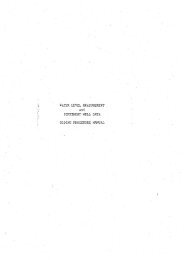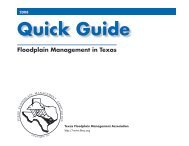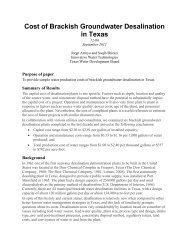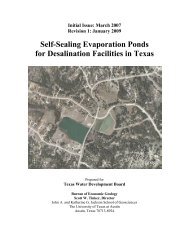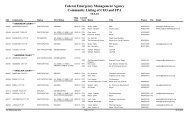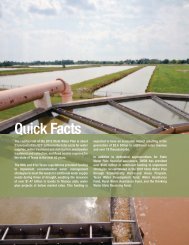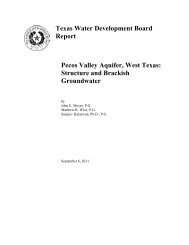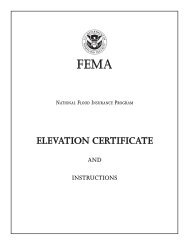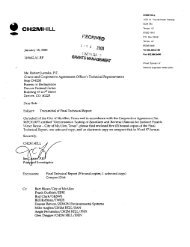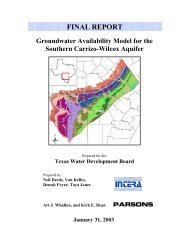Intensive Survey of the Guadalupe River Segment 1806
Intensive Survey of the Guadalupe River Segment 1806
Intensive Survey of the Guadalupe River Segment 1806
You also want an ePaper? Increase the reach of your titles
YUMPU automatically turns print PDFs into web optimized ePapers that Google loves.
SITE DESCRIPTION<br />
RESULTS AND DISCUSSION<br />
The <strong>Guadalupe</strong> <strong>River</strong> has its beginning in springs that form <strong>the</strong> North and<br />
South Forks in Kerr County west <strong>of</strong> Kerrville. These two forks join near <strong>the</strong><br />
community <strong>of</strong> Hunt, and <strong>the</strong> mainstream flows eastward into Kendall and Comal<br />
counties where it turns and flows south to <strong>the</strong> Gulf <strong>of</strong> Mexico. Its total<br />
length is approximately 678.2 kilometers (421.4 miles). One major reservoir,<br />
Canyon Lake, and several smaller ones, Lake McQueeney, Lake Dunlap, Lake<br />
Placid, Lake Gonzales, Wood Lake, and Meadow Lake are located on <strong>the</strong> river.<br />
The <strong>Guadalupe</strong> <strong>River</strong> is very scenic, and sufficient stream flow for recrea<br />
tional use exists throughout its entire length, with <strong>the</strong> exception <strong>of</strong> <strong>the</strong><br />
extreme headwaters.<br />
<strong>Segment</strong> <strong>1806</strong> <strong>of</strong> <strong>the</strong> <strong>Guadalupe</strong> <strong>River</strong> extends 168.2 km (104.5 mi) from <strong>the</strong><br />
confluence <strong>of</strong> <strong>the</strong> North and South Forks in Kerr County to <strong>the</strong> headwaters <strong>of</strong><br />
Canyon Lake, 2.7 km (1.7 mi) downstream <strong>of</strong> Rebecca Creek Road in Comal<br />
County. The drainage area <strong>of</strong> <strong>the</strong> segment is located in <strong>the</strong> central Texas<br />
region known as <strong>the</strong> Edwards Plateau. Rolling hills covered by cedar and<br />
liveoak and underlain by thin soils and limestone outcrops are typical <strong>of</strong> <strong>the</strong><br />
area. Within this region bald cypress trees line <strong>the</strong> banks <strong>of</strong> <strong>the</strong> <strong>Guadalupe</strong><br />
<strong>River</strong>. The river water is usually crystal clear and swift flowing; thus, it is<br />
inviting for recreational uses. During September 1985-August 1986, 463,116<br />
people utilized Kerrville State Park, located along <strong>the</strong> <strong>Guadalupe</strong> <strong>River</strong> near<br />
Kerrville, (TPW, 1986). The park is located adjacent to Flat Rock Lake a<br />
small mainstream impoundment formed by Flat Rock Dam. Far<strong>the</strong>r downstream<br />
near Spring Branch, 231,426 people frequented <strong>Guadalupe</strong> <strong>River</strong> State Park<br />
during <strong>the</strong> same time period. The area near <strong>the</strong> park is one <strong>of</strong> <strong>the</strong> most<br />
scenic and popular white water areas for canoeing in Texas.<br />
Stream flow within <strong>Segment</strong> <strong>1806</strong> alternates between riffle and pool areas and<br />
in most cases <strong>the</strong> cross section <strong>of</strong> <strong>the</strong> stream bed is broad and flat. The<br />
stream bottom is typically limestone bedrock or accumulations <strong>of</strong> gravel and<br />
limestone cobble; siltation is usually evident only in <strong>the</strong> pooled areas. The<br />
true character <strong>of</strong> <strong>the</strong> river channel has been altered by <strong>the</strong> construction <strong>of</strong><br />
numerous impoundments which are used for recreation and/or water supply.<br />
The larger <strong>of</strong> <strong>the</strong>se within <strong>the</strong> study area are Ingram Lake, Upper <strong>Guadalupe</strong><br />
<strong>River</strong> Authority (UGRA) Lake, Flat Rock Lake and Center Point Lake. There<br />
are many intermittent tributaries and fewer perennial spring fed streams<br />
which provide inflow to <strong>the</strong> <strong>Guadalupe</strong> <strong>River</strong> in <strong>Segment</strong> <strong>1806</strong>.<br />
The small communities <strong>of</strong> Hunt, Ingram, Center Point, and Spring Branch and<br />
<strong>the</strong> larger City <strong>of</strong> Kerrville are drained by <strong>the</strong> <strong>Guadalupe</strong> <strong>River</strong> and its<br />
tributaries within <strong>Segment</strong> <strong>1806</strong>. Kerrville is <strong>the</strong> county seat <strong>of</strong> Kerr County<br />
and one <strong>of</strong> <strong>the</strong> state's most popular health and recreational centers. More<br />
than a dozen boys and girls camps and several adult camps and dude ranches<br />
cater to tourists from throughout <strong>the</strong> United States. Besides tourism,<br />
ranching (sheep, cattle, goats) is extensively practiced in <strong>the</strong> area. Some


